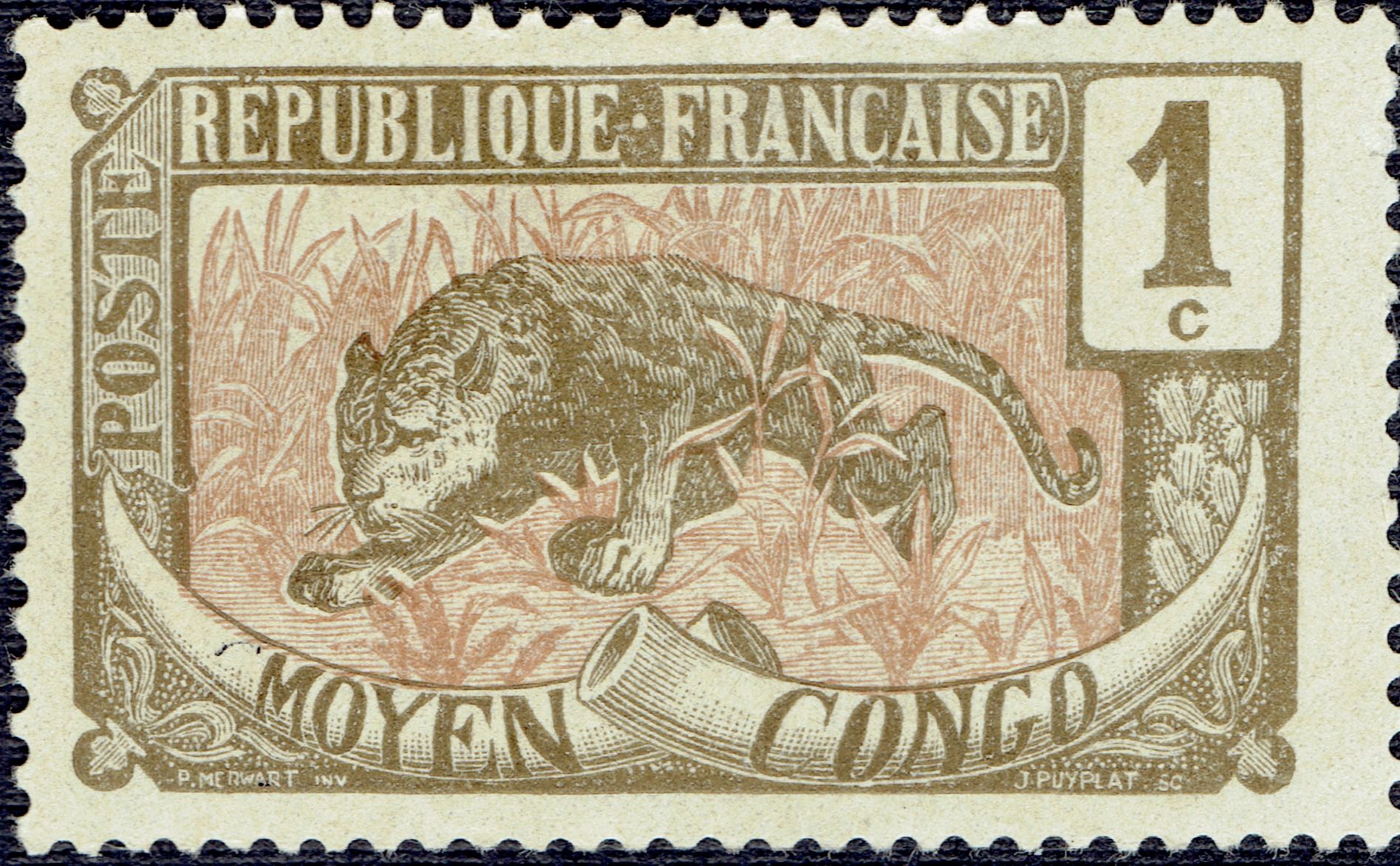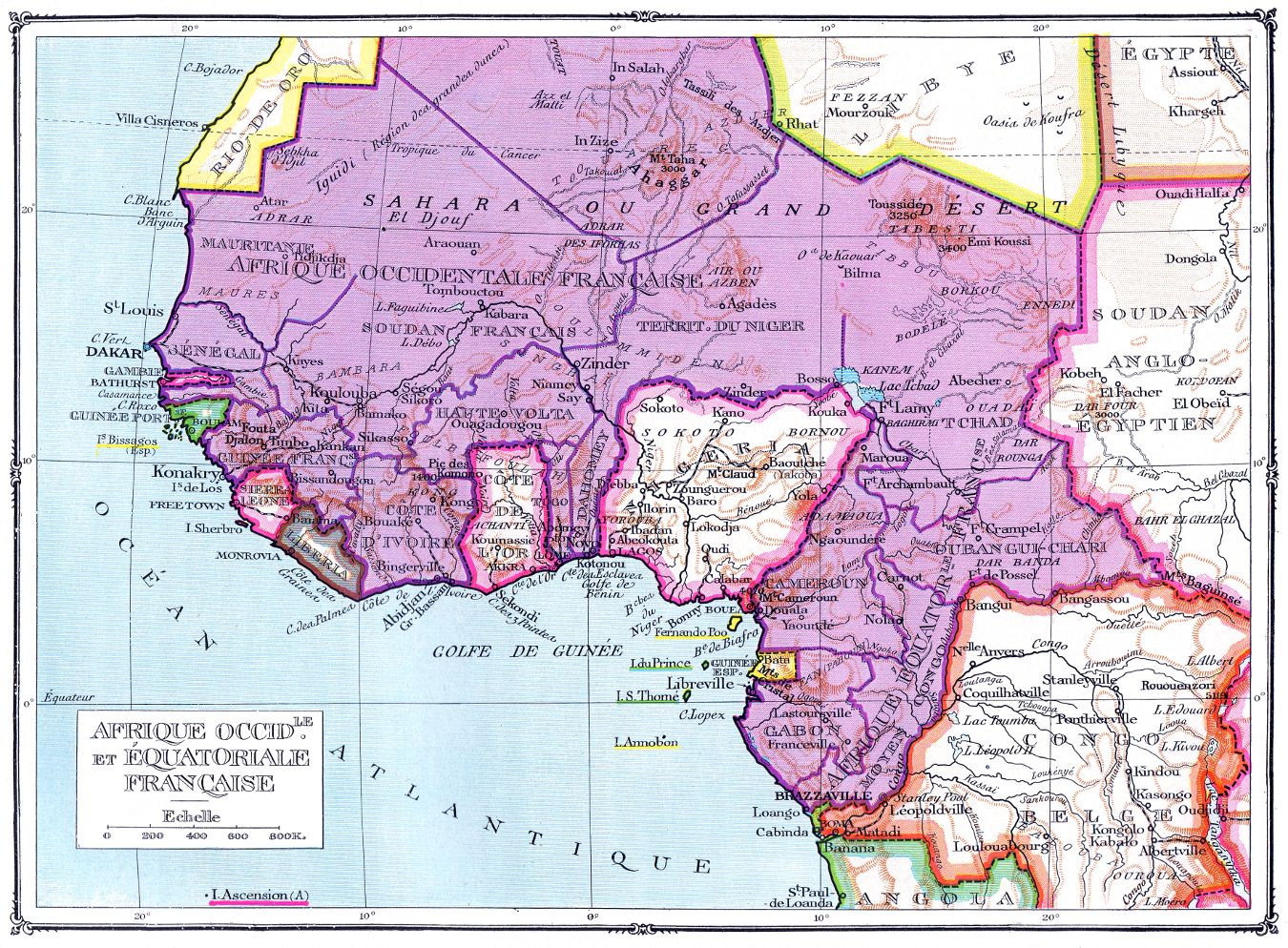
Wait a minute….hasn’t this stamp appeared on ‘A Stamp A Day’ before? Well, yes and no. A number of French possessions in western Africa overprinted the first three designs issued by Middle Congo, usually in changed colors. The lower-denomination leopard stamps are the only designs that I currently own from a few of these colonial entities. Previously, I have included these stamps on the entries about the French Mandate of Cameroun (Scott #148, issued in 1921), the Territory of Chad (Scott #1, 1922), and Ubangi-Shari (Scott #23, 1922). Much of the history of the region has already been recounted in the above entries as well as others, including French Equatorial Africa, Republic of the Congo (also known as Congo-Brazzaville), Congo Free State, and Belgian Congo, amongst others so today’s entry will be rather brief.
Before I started this blog a little over one year ago, I wasn’t very interested in many of these African issuers as I found them confusing. Darkest Africa is now a bit less dark for me as I am beginning to understand the vast array of territorial claims and the numerous name- and boundary changes from the nineteenth century to the present-day. African history and stamps now fascinate me and I’m striving to learn as much as I can.
Originally called the French Congo (Congo français), the area of Middle Congo (Moyen-Congo) at one time comprised the present-day area of the Republic of the Congo (Congo-Brazzaville), Gabon, and the Central African Republic.

The French Congo began at Brazzaville on September 10, 1880, as a protectorate over the Bateke people along the north bank of the Congo River. It was formally established as the French Congo on November 30, 1882, and was confirmed at the Berlin Conference of 1884–85. Its borders with Cabinda, Cameroons, and the Congo Free State were established by treaties over the next decade. The plan to develop the colony was to grant massive concessions to some thirty French companies. These were granted huge swaths of land on the promise they would be developed. This development was limited and amounted mostly to the extraction of ivory, rubber, and timber. These operations often involved great brutality and the near enslavement of the locals.
Even with these measures most of the companies lost money. Only about ten earned profits. Many of the companies’ vast holdings existed only on paper with virtually no presence on the ground in Africa.
The French Congo was sometimes known as Gabon-Congo. It formally added Gabon on in 1891, was officially renamed Middle Congo (Moyen-Congo) in 1903, was temporarily divorced from Gabon in 1906, and was then reunited as French Equatorial Africa (Afrique équatoriale française, or the AEF) in 1910 in an attempt to emulate the relative success of French West Africa.
The AEF contained five territories: Middle Congo, Gabon, Oubangui-Chari, Chad, and French Cameroon (after World War I), although the last was not organized as a separate entity until 1920. The Governor-General was based in Brazzaville with deputies in each territory. In 1911, France ceded parts of the territory to German Kamerun as a result of the Agadir Crisis. The territory was returned after Germany’s defeat in World War I, while most of Cameroon proper became a French League of Nations mandate not integrated into the AEF.
The first post office in French Congo was opened at Brazzaville in 1881, in Brazzaville, mail being processed through Gabon. The general issues for the French colonies are used. In 1886, these were superseded by the issues for Gabon and, from 1891, by the stamps of French Congo. After Middle Congo has been established as a separate colony, stamps were issued starting in 1907 inscribed MOYEN CONGO (Scott #1-22). The first set of designs was identical to the last set of French Congo. This set was reissued beginning in 1924 overprinted AFRIQUE EQUATORIALE FRANÇAISE (Scott #23-50). These were surcharged with new values between 1924 and 1927 (Scott #51-60).

Stamps of Middle Congo were used in Ubangi Shari and Chad after the postal network was expanded in French Equatorial Africa. These were superseded by issued for Ubangi Shari Chad starting in 1915.
Middle Congo participated in the Colonial Exposition omnibus issue in 1931 (Scott #61-64) and released a long set using three designs in 1933 (Scott#65-88), the final of its general issues. There were also two semi-postal stamps created in 1916 by surcharging the 1907 5-centime leopard stamps (Scott #B1-B2) and several sets of postage due stamps. The first of these were made in 1926 by overprinting French postage due stamps with the inscription MOYEN-CONGO / A.E.F. in black (Scott #J1-11). A set of postage dues released in 1930 are unusual in that they were printed in the standard larger size of Middle Congo’s pictorials and included new pictorial designs. These were also bicolored and included the additional inscription of AEF for Afrique Equatoriale Française (Scott #J12-22). The final set was a set of single-color large-sized stamps, without the AEF designation released in 1933 (Scott #J23-33).
Starting in 1936, the stamps of Middle Congo were superseded by the issues of French Equatorial Africa. These were replaced by stamps issued by the self-governing Republic of Congo in 1959 and the independent Republic of Congo in 1960.
Scott #1, released in 1907, is a one-centime olive gray and brown stamp, typographed on unwatermarked paper and perforated 14×13½. It portrays a leopard stalking its prey through the savannah grasses. The leopard (Panthera pardus) is one of the five “big cats” in the genus Panthera. It is a member of the family Felidae with a wide range in sub-Saharan Africa and parts of Asia. Fossil records suggest that in the Late Pleistocene it occurred in Europe and Japan.
Compared to other members of Felidae, the leopard has relatively short legs and a long body with a large skull. It is similar in appearance to the jaguar, but has a smaller, lighter physique. Its fur is marked with rosettes similar to those of the jaguar, but the leopard’s rosettes are smaller and more densely packed, and do not usually have central spots as the jaguar’s do. Both leopards and jaguars that are melanistic are known as black panthers.
The leopard is distinguished by its well-camouflaged fur, opportunistic hunting behavior, broad diet, and strength (which it uses to move heavy carcasses into trees), as well as its ability to adapt to various habitats ranging from rainforest to steppe, including arid and montane areas, and its ability to run at speeds of up to 36 miles per hour (58 kilometers per hour).
The leopard is listed as vulnerable on the IUCN Red List because leopard populations are threatened by habitat loss and fragmentation, and are declining in large parts of the global range. In Hong Kong, Singapore, Kuwait, Syria, Libya, Tunisia and most likely in Morocco, leopards have already been extirpated. Leopards are hunted illegally, and their body parts are smuggled in the wildlife trade for medicinal practices and decoration.



